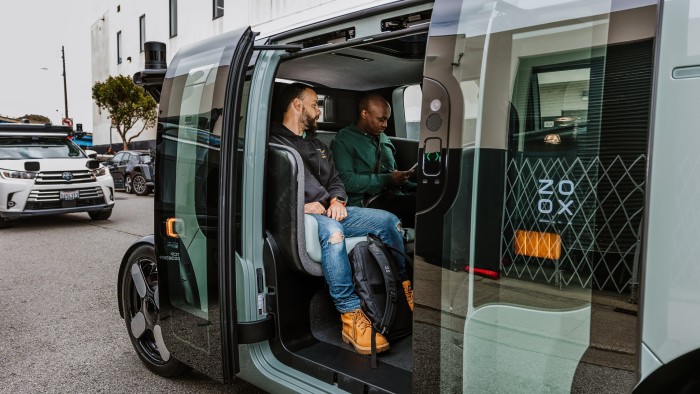Unlock the Editor’s Digest for free
Roula Khalaf, Editor of the FT, selects her favourite stories in this weekly newsletter.
Amazon’s self-driving start-up Zoox will scale up production next year, as it accelerates plans for a commercial rollout of its fleet of robotaxis in the US.
The company, which manufactures and operates a bespoke pod-shaped vehicle without a steering wheel, will open a new site in California’s Bay Area to expand its footprint beyond a current small production facility in Fremont, Zoox co-founder Jesse Levinson told the Financial Times.
Zoox will use the facility to increase its fleet significantly having so far deployed about two dozen bespoke test vehicles across six US cities. It plans to launch public rides in Las Vegas this year followed by San Francisco.
“We’ll have a lot more [vehicles] by the end of the year. And then next year is when we really start what we call serial production,” said Levinson. He added the new site will enable Zoox to get “ready to make hundreds and then thousands” of its custom-built robotaxis.
Zoox’s expansion comes as President Donald Trump’s administration last month announced plans to loosen rules to make it easier to deploy self-driving cars on US roads amid competition from China’s BYD and other start-ups developing the technology.
Increased vehicle production will enable Zoox to compete more effectively with US rivals such as Alphabet’s Waymo, which modifies vehicles from manufacturers including Jaguar and Geely’s Zeekr, as well as Elon Musk’s Tesla. Waymo is the only one that has launched a fully public service in the US, after rolling out its fleet in San Francisco three years ago.
Levinson said it was fortuitous that Zoox’s vehicles were assembled in California at a time when Waymo is expected to face higher costs to import Zeekr vehicles from China amid Trump’s trade offensive. Waymo did not respond to a request for comment.
“We’re happy to be a California company actually manufacturing vehicles in California,” he said. “There isn’t a lot of that right now.”
The move to increase production also marks a doubling down by Amazon on its self-driving bet after it acquired Zoox for $1.3bn in 2020. Zoox operates as an independent subsidiary of the US ecommerce giant with its own chief executive, former Intel executive Aicha Evans, but is still overseen by Amazon executives.
The venture has grown from 100 employees in 2020 to about 2,500 employees today. It recently signed a lease for a 200,000 square foot office near its headquarters in Foster City, California.

“We had raised a billion dollars prior to the acquisition. That’s a lot of money by any normal standards. It just turns out not to be a lot of money in this particular space,” Levinson said.
Although several car manufacturers are developing autonomous vehicles aimed for the robotaxi market, Zoox is considered one of the few serious US alternatives to Waymo after General Motors shut down its Cruise project last year, writing off $10bn in investment. An accident involving one of its vehicles and a pedestrian also set back Cruise’s ambitions.
Zoox on Tuesday said it submitted a voluntary recall with the US agency that enforces vehicle safety standards after one of its robotaxis collided with a passenger vehicle in Las Vegas last month. The incident resulted in no injuries and the company has since resumed testing after updating its fleet’s software.
Levinson said in an FT interview prior to the recall that robotaxi operators should be held to higher standards than human drivers. “The public has less patience for robotaxi mistakes.”
Elon Musk’s Tesla is aiming to roll out its version of a self-driving taxi this year in Austin, Texas, but plans to rely on cameras and less expensive sensors. Musk has forecast that Tesla will have 10mn autonomous vehicles on roads “in a few years” after mass production of its “Cybercabs” begins next year.
Levinson dismissed concerns that Musk’s relationship with the US administration, including overseeing the lay-offs of officials at the National Highway Traffic Safety Administration who were responsible for oversight of self-driving technologies, could dilute safety standards.
“I have faith in the US government to have the correct checks and balances and maintain public safety,” he said.
Additional reporting by Kana Inagaki in London




